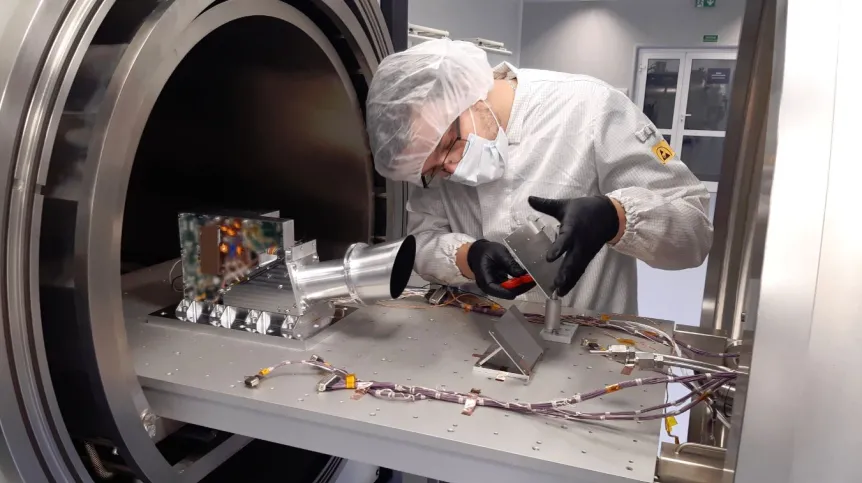
The construction of the engineering model of the GLOWS instrument has already been completed at the Space Research Center PAS. Tests are successful, the center reports. GLOWS is designed for the NASA's research mission IMAP.
GLOWS (GLObal solar Wind Structure) is a photometer designed to investigate the global heliolatitude structure of the solar wind and its evolution during the solar cycle. Additionally, GLOWS will investigate the distribution of interstellar neutral hydrogen (ISN H) and the solar radiation pressure acting on ISN H.
The GLOWS experiment is part of the NASA research mission IMAP (Interstellar Mapping and Acceleration Probe). The satellite will study the heliosphere, i.e. the area where the pressure of solar wind is higher than that of interstellar matter.
The NASA's IMAP research satellite is scheduled for launch in 2025. It will be equipped with ten scientific instruments, one of which - GLOWS - is being built created at the Space Research Center of the Polish Academy of Sciences in Warsaw.
Professor Maciej Bzowski, head of the GLOWS team, said: “As part of the preparation of the experiment, we designed the entire device: optical system, electronics, power supply system, software to collect data on board and transmit it to Earth and the concept data processing system on Earth.”
The group made prototypes of individual components of the instrument and tested them in laboratory conditions.
Bzowski continued: “We built a computer model of the heliospheric glow, studied the extra-heliospheric background expected in the experiment, we identified and introduced known astrophysical sources of Lyman-alpha radiation into the model, we have built a list of stars that will be used to calibrate the instrument. We also built a GLOWS prototype and put it into operation laboratory. Finally, we verified that the instrument can see the Lyman-alpha light, that we want to observe in space. This means that we registered the first light.”
GLOWS is the first completely Polish experiment and instrument prepared for a NASA mission.
Director of the Space Research Center of the Polish Academy of Sciences, Professor Iwona Stanisławska, said: “We have been given the opportunity to plan the experiment, build an absolutely proprietary device and track the data it will record. I also think that we will be the first to present our own results of these unique measurements.”
At the turn of September this year, GLOWS passed the Critical Design Review (CDR) by experts from Johns Hopkins University, Southwest Research Institute and NASA. CDR was a success which meant that - after implementing the reviewers' recommendations - Polish specialists could start building the device proper, the flight model that would be sent into space, and continue testing the engineering model.
Dr. Roman Wawrzaszek from the Laboratory of Satellite FPGA Applications of the Space Research Center PAS said: “The complete model was illuminated with a light of the target wavelength . The test was carried out in a vacuum chamber under conditions similar to those we predict in orbit.
“The instrument recorded a signal, i.e. the +first light+, according to expectations. That is, (...) the engineering prototype works.”
According to the project manager Karol Mostowy, in the coming months, the engineers of the GLOWS team will be working on finalizing the production of subassemblies for the qualifying and flight model of the GLOWS instrument. The next important milestone in the project are the tests of the qualification model.
The Ministry of Education and Science allocated PLN 16 million to the construction of the instrument and conducting the GLOWS experiment (years 2021-2026).
The IMAP mission is created by the international scientific team led by Professor David J. McComas from the Princeton University, and the implementation of the project is coordinated by Applied Physics Laboratory (APL) at the of Johns Hopkins University. The Science Mission Directorate's Heliophysics Division coordinates the mission on behalf of NASA.
The members of the international IMAP mission consortium also include APL, MIT, Caltech, JPL/NASA and several other research and university centres.
PAP - Science in Poland
agt/ kap/
tr. RL













